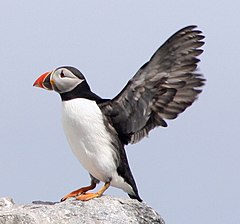Fratercula
Wygląd
| Fratercula[1] | |||
| Brisson, 1760[2] | |||
 Przedstawiciel rodzaju – maskonur zwyczajny (F. arctica) | |||
| Systematyka | |||
| Domena | |||
|---|---|---|---|
| Królestwo | |||
| Typ | |||
| Podtyp | |||
| Gromada | |||
| Podgromada | |||
| Infragromada | |||
| Rząd | |||
| Podrząd | |||
| Parvordo | |||
| Nadrodzina | |||
| Rodzina | |||
| Podrodzina | |||
| Rodzaj |
Fratercula | ||
| Typ nomenklatoryczny | |||
|
Alca arctica Linnaeus, 1758 | |||
| Synonimy | |||
|
| |||
| Gatunki | |||
| |||
Fratercula – rodzaj ptaków z podrodziny nurniczków (Aethiinae) w rodzinie alk (Alcidae).
Zasięg występowania
[edytuj | edytuj kod]Rodzaj obejmuje gatunki występujące w Eurazji i Ameryce Północnej[11].
Morfologia
[edytuj | edytuj kod]Długość ciała 26–41 cm, rozpiętość skrzydeł 47–63 cm; masa ciała 460–773 g[11].
Systematyka
[edytuj | edytuj kod]Etymologia
[edytuj | edytuj kod]- Fratercula: średniowiecznołac. fraterculus „mnich”, od łac. fraterculus „braciszek”, od zdrobnienia frater „brat”; prawdopodobnie z korpulentnego wyglądu maskonura i jego czarno-białego upierzenia[12].
- Lunda: far. nazwa Lunda dla maskonura zwyczajnego[12]. Gatunek typowy: Alca cirrhata Pallas, 1769.
- Mormon: w mitologii greckiej Mormon (gr. Μορμω Mormō) to kobieta-widmo, upiór, którym opiekunki w starożytnej Grecji straszyły dzieci[12]. Gatunek typowy: Alca arctica Linnaeus, 1758.
- Larva: łac. larva „zjawa, duch, maszkaron”[12]. Gatunek typowy: Alca arctica Linnaeus, 1758.
- Puffinus: angielskie nazwy Puffing (z 1502) lub Puffin (z 1508), początkowo stosowane do tuszy z pisklęcia burzyka, przysmaku angielskiego stołu do końca XVIII wieku. Przez zamieszanie i skojarzenia nazwy te stopniowo zaczęto stosować również na określenie maskonura, stając się nazwą tego gatunku w drugiej połowie XIX wieku, ale w ornitologii zachowano je jako ogólną nazwę dla burzyków[12]. Gatunek typowy: Puffinus flavirostris S.D.W., 1836 (= Alca arctica Linnaeus, 1758).
- Ceratoblepharum: gr. κερας keras, κερατος keratos „róg”; βλεφαρον blepharon „powieka”[12]. Gatunek typowy: Alca arctica Linnaeus, 1758.
- Gymnoblepharum: gr. γυμνος gumnos „goły, nagi”; βλεφαρον blepharon „powieka”[12]. Gatunek typowy: Alca cirrhata Pallas, 1769.
- Sagmatorrhina: gr. σαγμα sagma, σαγματος sagmatos „osłona tarczy, derka”; ῥις rhis, ῥινος rhinos „nozdrza”[12]. Gatunek typowy: Sagmatorrhina lathami Bonaparte, 1853 (= Alca cirrhata Pallas, 1769).
- Cheniscus: gr. χηνισκος khēniskos „gąska”, od zdrobnienia χην khēn, χηνος khēnos „gęś”[12]. Gatunek typowy: Alca cirrhata Pallas, 1769.
Podział systematyczny
[edytuj | edytuj kod]Do rodzaju należą następujące występujące współcześnie gatunki[13]:
- Fratercula cirrhata (Pallas, 1769) – maskonur złotoczuby
- Fratercula arctica (Linnaeus, 1758) – maskonur
- Fratercula corniculata (J.F. Naumann, 1821) – maskonur pacyficzny
Opisano również gatunek wymarły:
- Fratercula dowi Guthrie, Thomas & Kennedy, 2000[14]
Przypisy
[edytuj | edytuj kod]- ↑ Fratercula, [w:] Integrated Taxonomic Information System (ang.).
- ↑ M.J. Brisson: Ornithologie, ou, Méthode contenant la division des oiseaux en ordres, sections, genres, especes & leurs variétés, a laquelle on a joint une description exacte de chaque espece, avec les citations des auteurs qui en ont traité, les noms quils leur ont donnés, ceux que leur ont donnés les différentes nations, & les noms vulgaires. T. 6. Parisiis: Ad Ripam Augustinorum, apud Cl. Joannem-Baptistam Bauche, bibliopolam, ad Insigne S. Genovesae, & S. Joannis in Deserto, 1760, s. 81. (fr. • łac.).
- ↑ P.S. Pallas: Zoographia Rosso-Asiatica: sistens omnium animalium in extenso Imperio Rossico, et adjacentibus maribus observatorum recensionem, domicilia, mores et descriptiones, anatomen atque icones plurimorum. T. 2. Petropoli: Ex Officina caes. Academiae Scientiarum, 1811, s. 363. (łac.).
- ↑ J.K.W. Illiger: Prodromus systematis mammalium et avium, additis terminis zoographicis utriusque classis, eorumque versione germanica. Berolini: Sumptibus C. Salfeld, 1811, s. 283. (łac.).
- ↑ L.J.P. Vieillot: Analyse d’une nouvelle ornithologie élémentaire. Paris: Deteville, libraire, rue Hautefeuille, 1817, s. 67. (fr.).
- ↑ S.D.W.. The birds of Britain, systematically arranged. „The Analyst”. 3, s. 211, 1835–1836. (ang.).
- ↑ Brandt 1837 ↓, s. 348.
- ↑ Brandt 1837 ↓, s. 349.
- ↑ Ch.-L. Bonaparte. On the largest known species of Phaleridine Bird. „Proceedings of the Zoological Society of London”. 19, s. 202, 1851. (ang.).
- ↑ G.R. Gray: Catalogue of the genera and subgenera of birds contained in the British Museum. London: The Trustees, 1855, s. 127. (ang.).
- ↑ a b D.N. Nettleship: Family Alcidae (Auks). W: J. del Hoyo, A. Elliott, J. Sargatal: Handbook of the Birds of the World. Cz. 3: Hoatzin to Auks. Barcelona: Lynx Edicions, 1996, s. 720–721. ISBN 84-87334-20-2. (ang.).
- ↑ a b c d e f g h i Etymologia za: The Key to Scientific Names, J.A. Jobling (red.), [w:] Birds of the World, S.M. Billerman et al. (red.), Cornell Lab of Ornithology, Ithaca (ang.).
- ↑ Systematyka i nazwy polskie za: P. Mielczarek, M. Kuziemko: Podrodzina: Aethiinae Anonymous, 1908 – nurniczki (wersja: 2015-10-31). [w:] Kompletna lista ptaków świata [on-line]. Instytut Nauk o Środowisku Uniwersytetu Jagiellońskiego. [dostęp 2020-01-13].
- ↑ A.A. Badikova, F.Ya. Dzerzhynsky, Functional morphology and adaptive features of the jaw apparatus in puffins (Fraterculini, Alcidae, and Charadriiformes), „Biology Bulletin”, 42 (7), 2015, s. 622–632, DOI: 10.1134/S106235901507002X, ISSN 1608-3059 (ang.).
Bibliografia
[edytuj | edytuj kod]- J.F. von Brandt, Rapport sur une monographie de la famille des Alcadées, „Bulletin Scientifique de l’Académie Impériale des Sciences de St. Pétersbourg”, 2, 1837, s. 344–349 (fr.).